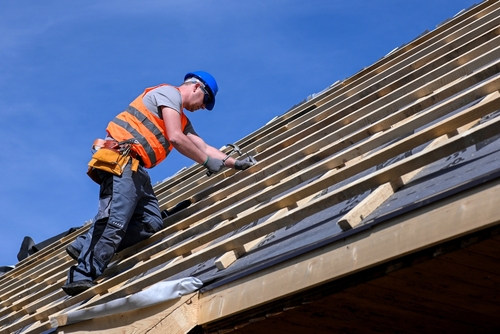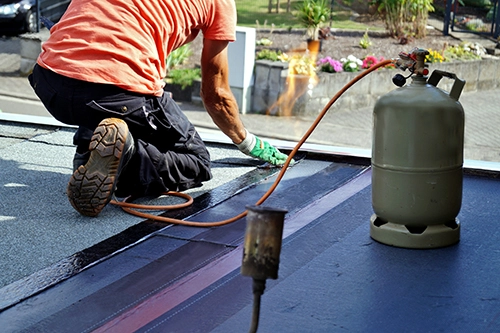- About Us
- Services
- Blog
- Contact
Need a quote?
As a leading London Roofing company, people often ask us how often their roof might need replacing. This question can vary a lot and the answer generally depends on what their roof was built from in the first place.
So, let’s talk about modern roofing materials, how they’ve changed over time, and how long you can expect your new roof to last.




Before we talk about the benefits of modern roofing materials, we should also note that there are some restrictions in place now that weren't there in years gone by - and for good reasons!
As building standards have improved over the last century building materials that were once thought safe have, in many cases, been reassessed. Perhaps the most notable example of this is asbestos which, although cheap to produce and highly effective as a form of insulation, has been linked to many cases of lung cancer. Similarly, materials treated with harmful chemicals have also been phased out over time.
Of course, it’s entirely sensible to ban materials that could harm people or the environment and if your roof was built with these materials then you’ll probably want to get it replaced. That being said, such restrictions do place some limitations on how durable modern roofs can be.
With all that being said, there are plenty of modern roofing innovations that have more than made up for the materials we’ve had to phase out.
From synthetic polymers used in insulation sheets to more resistant, environmentally designed materials, modern roofing materials are highly effective and long-lasting.
While this will depend a lot on various environmental factors, as a rule, you can expect the average household roof to stay in good condition for between 20 and 50 years. Of course, it’s worth noting that this lifespan can be drastically reduced if your roof is not well maintained.
Damage as a result of one-off events - such as debris blown by a storm - can spread if not repaired quickly. This harms the overall integrity of the roof meaning that, even once you do repair the damage, the materials are more likely to degrade over time. That’s why you should always be sure to contact a London roofing company as soon as the damage occurs.
Not sure about the state of your roof? Not to worry! Here at Environ Roofing, our experienced team can conduct a fully comprehensive roofing survey to give you a clear picture of what’s going on. Get in touch today by calling 020 3535 6957 or emailing info@environroofingservices.co.uk for the best roofing company in London.
It depends on the construction, but the minimum weight a flat roof must be capable of bearing is 300lbs. This refers to a concentrated weight where a load is positioned on just one area of the roof. So, for example, a commercial flat roof can approximately support a 300lb HVAC unit in a 2.5×2.5ft single space.
If you opt for a flat roof anywhere on your property, remember that it comes with a need for proper maintenance. Low-slope roofing London-wide should be checked every six months or so, or after spells of bad weather, to spot any signs of damage. No matter how small, these should be addressed before they escalate. Remove any debris (leaves, twigs and so on) regularly to avoid these blocking the gutters and allowing water to pool and stand on the roof.
If there are trees in the close vicinity, keep them cut back to reduce the amount of foliage that falls on your flat roof. And check internally for signs of moisture, dampness or water damage on a regular basis. Spotting problems early means resolving them will be cheaper in the long run.

Building a flat roof can be done in three ways. The simplest and most cost-effective choice for levelled roofing London-wide is to construct a warm roof where a roofing membrane is placed over the insulation that keeps the timber structure warm. Another option is to create a cold roof where insulation is positioned between the rafters under the ply roof covering. This is commonly applied to flat-roofed extensions.
The third method is the hybrid roof that contains diverse elements. Their designs require a gap of ventilation above a warm roof to prevent excess moisture within the roof structure.
If you’re looking for flat roofing local contractors, don’t just select the first firm you come across. Find a roofing company that’s been in business for a while and can demonstrate a good track record in installing, repairing, and replacing flat roofs specifically. Ask for recommendations from your own network or from a local trade association. If you need refurbishment work done to 50% or more of your roof, you’ll need a roofing contractor who can self-certify their work under the Competent Person Scheme. Otherwise, the Building Control department at your local authority will need to approve the job before it begins.
Ask whether they are covered by liability insurance and how long they’ll guarantee the work they will carry out. And never just opt for the cheapest quote unless you’re quite sure they’re the best company for the job. You can’t afford to compromise on your roof as the structural integrity of your property depends on it.
Ensuring your flat roof will comply with building regulations before installation can save property owners time, money and stress. First, the roof must have a slope of around 1:80, with water draining away to one or two roof edges. Waterproofing must be extended up to the adjacent walls with at least 150 mm from the surface of the roof.
Contractors must install ventilation in cold roofs. For warm roofs, the deck must be bonded with a VCL. The roof should have the capacity to withstand strong winds and be sturdy enough to take an individual’s weight. Finally, check whether planning permission is needed. Typically, this is only required if you live in a conservation area or a listed building, or are making significant changes to an existing roof.
If you’re looking for top roofing solutions at competitive rates, check out our range of roofing services at Environ Roofing Company London. To get started, call one of our representatives today!

